| Columns Retired Columns & Blogs |
Another loudspeaker in this price range is Monitor Audio Gold 100 (around $1,700/pair), EISA award winner :-) ........
I used DRA Labs' MLSSA system and a calibrated DPA 4006 microphone to measure the Wharfedale Linton Heritage's frequency response in the farfield and an Earthworks QTC-40 mike for the nearfield responses. I usually leave a loudspeaker's grille off for the measurements. However, as the Linton's front baffle is set into the enclosure and the grille frame provides some acoustic profiling around the drive-units, I left the grille in place for most of the measurements. Interestingly, the labels on the boxes suggested that the speakers being reviewed were the exact same samples that had impressed me at the 2019 AXPONA last April.
Wharfedale specifies the Linton's sensitivity as 90dB at 1m for 2.0V input rather than 2.83V, the latter equivalent to 1W with an 8 ohm speaker. My estimate with the usual 2.83V was lower, at 88.1dB(B)/m, though this is a little higher than the average of all the loudspeakers I have measured. The impedance is specified as 6 ohms; the solid trace in fig.1 shows that the Linton's impedance is close to 6 ohms for much of the audioband. However, the minimum magnitude is 3.4 ohms at 130Hz, and there is a demanding combination of 5 ohms magnitude and –46° electrical phase angle (dotted trace) at 83Hz. The Wharfedale will work best with amplifiers that are comfortable driving 4 ohms.
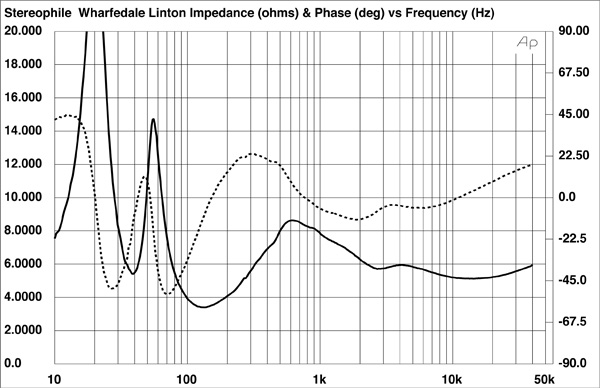
A small discontinuity just below 300Hz in the impedance traces suggests some sort of resonance in that region. When I investigated the enclosure's vibrational behavior with a plastic-tape accelerometer, I found a pair of strong, high-Q modes at 281Hz and 300Hz on the sidewalls (fig.2). The 281Hz mode was also present on the top and rear panels, and there was also a strong mode at 660Hz on the rear panel. The lower-frequency modes are high enough in level that I would have thought they would lead to some midrange congestion.
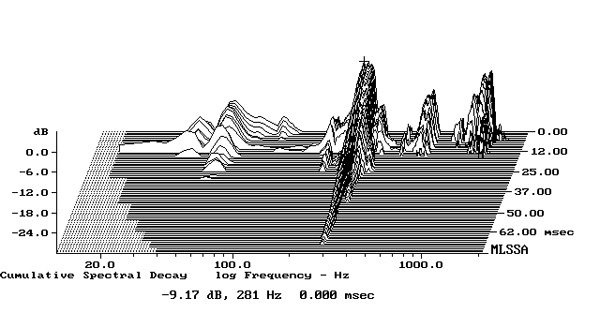
The impedance-magnitude plot has a saddle centered on 39Hz, which implies that this is the tuning frequency of the two flared ports on the Linton's rear panel. The blue trace in fig.3 shows the woofer's nearfield response, which has a minimum-motion notch at 41Hz. (This is the frequency at which the back pressure from the port resonance holds the cone stationary.) The nearfield response of the ports (red trace) peaks at the same frequency, and though its upper-frequency rolloff is disturbed by a broad peak around 200Hz, this is well down in level.
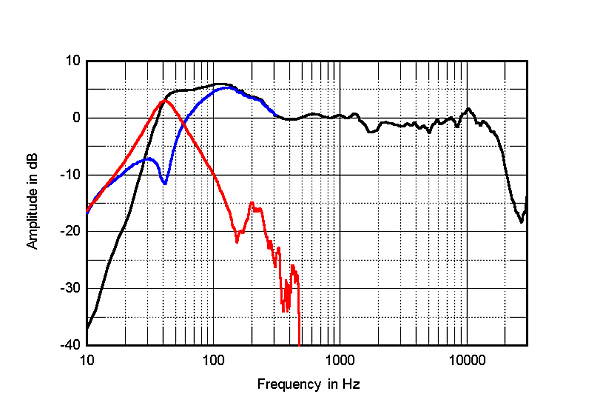
The black trace below 300Hz in fig.3 shows the sum of the nearfield woofer and port outputs, taking into account acoustic phase and the different distance of each radiator from a nominal farfield microphone position. The rise in response in the upper bass is due in part to the nearfield measurement technique. However, this graph does suggest that the port tuning is somewhat underdamped.
The Wharfedale's farfield response, averaged across a 30° horizontal window centered on the tweeter axis, is shown as the black trace above 300Hz. It is superbly flat and even up to 15kHz, above which the tweeter's output rapidly rolls off. This graph was taken with the grille in place. The response without the grille is very similar, but with the small suckout at the top of the midrange unit's passband slightly accentuated and a small peak introduced between 5 and 8kHz.
The Wharfedale's tweeter is positioned slightly closer to one side of the baffle than the other. I plotted the horizontal dispersion with the behavior off-axis on the tweeter side to the front in fig.4. With the relatively wide baffle, it is not surprising that the Linton becomes increasingly directional above 8kHz. There is also a slight flare off-axis at the bottom of the tweeter's passband, though this might be balanced in-room by the slightly dish-shaped on-axis response in the same region. In the vertical plane (fig.5), a suckout develops in the crossover region 10° below the tweeter axis, suggesting that the crossover and drive-unit polarities have been optimized for listening axes on and above the tweeter axis, which is around 36" from the floor with the speakers sitting on their dedicated stands.
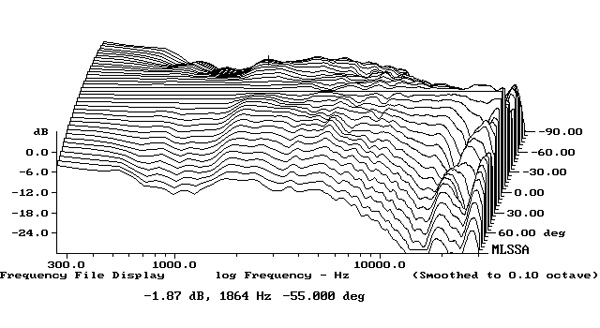
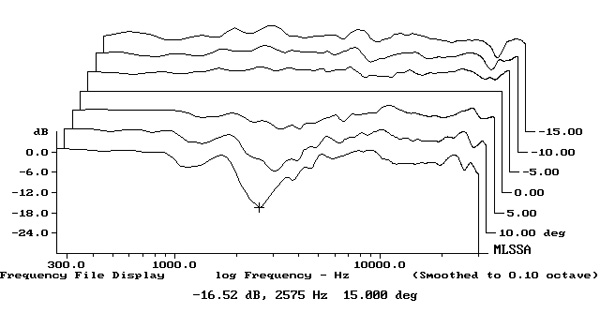
In the time domain, the Linton's step response (fig.6) indicates that the tweeter and midrange unit are connected in negative acoustic polarity, the woofer in positive polarity. (I checked this by looking at the nearfield step responses of the two lower-frequency units.) The decay of the tweeter's step smoothly blends with the start of the midrange unit's step, the decay of which smoothly blends with the start of the woofer's step. This reinforces the optimal crossover implementation seen in fig.3.
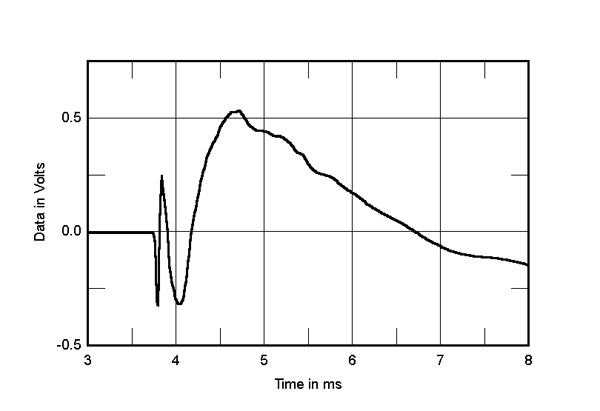
The Wharfedale's cumulative spectral decay plot (fig.7), taken with the grille removed, is relatively clean overall, though some low-level delayed energy can be seen in the low- and mid-treble regions. (As always with these plots, ignore the black ridge at exactly 15.75kHz, which is due to interference from the MLSSA host PC's video circuitry.)
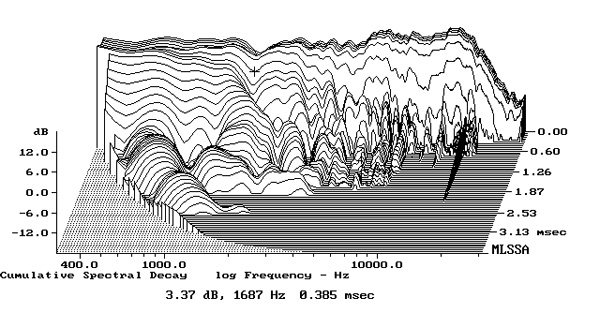
Overall, the Wharfedale Linton Heritage offers excellent measured performance, though that under-damped bass alignment might mean extra care having to be taken in room placement.—John Atkinson

Another loudspeaker in this price range is Monitor Audio Gold 100 (around $1,700/pair), EISA award winner :-) ........

… will never spend anywhere near the equivalent price of a new car for an audio system, really need? For $1,200 one can buy a pair of speakers that not only “merge a refined, elegantly detailed, full-range sound with a magnetic personality that [makes you] want to play records” but also offer “excellent measured performance”.
Regarding measurements, IMO JA1 should have (also) measured the speakers using the particular amps – especially the tube amps - that HR used for his listening evaluation. As seen in the Klipschorn review, the use of an amp with a non-negligible output impedance can have a significant effect upon the overall frequency response of the connected speakers.
It’s a bit unfortunate that HR did not also listen to the Lintons using amps more in keeping with their price. While choosing amps that are thought not to present a limiting factor is a valid premise, how many users are likely to match a $1,200 pair of speakers with a $5,000 amp (or even $3,500) - let alone a $5,000 phono cartridge? Plus, for the music lovers - as opposed to the audiophiles or equipment enthusiasts - of my acquaintance, a tube amp is a non-starter just as would be a tube-type TV. It would have been informative to determine by what increment the performance of the Linton might have been reduced by driving them with a sub $1,000 integrated amp, such as the Yamaha A-S801 or the Marantz PM-7005. Both amps are capable of over 100W into a 4 ohm load, have both phono and digital inputs and have tone controls that could be useful in adjusting the bass response of the Linton.
Coincidentally, perhaps, the Linton Heritage is approximately the same size as the original Advent speaker that was part of my first audio system and $1,200 is about what the price of a pair of those Advents would equate to today when adjusted for inflation.

Another integrated amp which could also be considered is the new Parasound NewClassic 200 with Class-D output ...... About $1,200 :-) ........

... for an extra $300 (or more) that the Yamaha or Marantz amps might lack?

John Curl design ...... May be worth it :-) .......

... class D power amp modules from Pascal Audio.
Did JC design them?

Most likely he was involved in designing the other parts of the component, such as the pre-amp section ....... Most likely he also listened to the final product and compared it's sound quality with his conventional design integrated, HINT6 :-) .........

May be also, less heat :-) .......

Also, the SVS Prime Wireless Soundbase ($500) could be considered ....... Class-D output and Wi-Fi/BT connectivity ....... See AudioStream :-) .......

"Coincidentally, perhaps, the Linton Heritage is approximately the same size as the original Advent speaker that was part of my first audio system and $1,200 is about what the price of a pair of those Advents would equate to today when adjusted for inflation."
So, you are implying we should try 'stacked Lintons!'
;-D
I would love that!

Glad, you didn't say stacked Clintons :-) ........

... side-by-side, which is how the local Advent dealer had them on display, driven by a McIntosh MC2105 amplifier.

Both examples of C-Lintons may look better side by side, rather than stacked :-) ..........

Stacked Advents bring back a lot of memories. I actually got to experience this setup back in 1978 driven by a Kenwood integrated. I felt like I was at stadium rock concert.

https://www.youtube.com/watch?v=ERYJg3PBJys&feature=youtu.be
doug s.

Size wise more like my old beloved Boston Acoustics A70's, 2 way suspension design that wouldn't get very loud but sure were sweet.
Comeau is on the right track here, I never did warm to the narrow towers sound. Still using old modded Advent Legacy II's as my every days, yet to hear a more modern design that was worth the coin for the upgrade. (< 1500 a pair with strict placement options).
Would be good to see more modern designs emerge with wider baffles/acoustic suspension designs.

Bobber05, I just picked up a pair of aDs L500 (ca. 1975) this weekend and I couldn't agree more about wanting to see more wide baffle/acoustic suspension designs, and paper cones.
The aDs are very smooth/sweet sounding, with full-bodied vocals. I've been eye-balling the Lintons for quite some time and came back here b/c of the aDs' sound. They make me wonder what a similar designed 3-way would sound like.
It looks like the frequency response of the Lintons is akin to similar sized Spendors and Harbeths, but far more affordable. The boosted bass is my main hesitation; maybe will have to consider using tone controls.
Cheers!
Jbreezy5

Sorry, off-topic of this review but...
In a Stereophile show report not long ago John Atkinson wrote that there was to be a follow-up review of the Joseph Audio Pulsars, now the "Graphene 2" version. Will you be doing that follow-up? Or will it perhaps be Michael Fremer?

did a Pulsar followup a couple issues back
herb

JA1 did a follow-up review of Perspective2 Graphene, couple of issues back ......... not, Pulsar2 Graphene :-) .........

I DID do a Pulsar followup
but it seems like a long time ago
(you know with me you always need a fact-checker)
sorry
herb

Yes, you did a Pulsar follow-up ....... But, that was previous generation ....... The current model is Pulsar2 Graphene ....... RH was referring to the current model ........ May be you could do another follow-up of the current generation Pulsar2 Graphene? :-) ..........

JA did the new Perspective 2s, not the Pulsars.
Cheers.

it seems that comeau has tried to rebuild the splendor sp1 on the cheap.considering the cost of the harbeth and spendor versions, to name but two current uk built iterations it would be useful to know if he has succeeded.

Now I am a LOT MORE interested.

and did not care for the sound. They look great and I'm sure will sell quite well- a great move by Wharfdale to fill a void in the speaker market and appear like a more affordable "Harbeth" type of monitor.
As for the sound- my ears prefer the KEF LS50 or used Harbeth P3ESR by a British country mile.....

Herb, the Stravinsky disc you used in the review is truly of demonstration quality as I got a copy today and was amazed at how great it sounded. Any other records you can recommend for demos that are easy to find and cheap?

I actually own the Wharfedale Denton 85 and as far as my small listening room is concerned it is as good as IT gets. I hope Stereophile will run a comparison between the Linton and the Denton 85 to explore the myth that a " good big one always beats a good small one "
This is an ideal opportunity to do this as the 2 models are designed by the same and highly competent engineer and use the same tweeter.
Unlike the Linton you can place the the Denton right against the rear wall and still get tight well controlled bass ....

Hello,
thank you for all great reviews.
I like this speakers, but are they neutral, transparent enough for acoustic and classic music ? I'm afraid they can add some their "personality" to sound ? Or are they clean and without own character ?
Would be new amp and streamer Marantz PM7000N good partner for Lintons ?
I prefer listening on low volume levels, I never listen loudly, so I need some speakers that are able to play quiet more than loud. How good are Lintons in this area ? Are there some better speakers (up to $1500-2000) for low level listening of acoustic, vocal and opera, baroque and classical music, for jazz and rock, world music ?
I heard some common speakers but I was not sold on them at all - it was mostly not able to play at lower levels, sound lack color and timbre, was too shouty, I was tired very quickly and missed emotions of music .. I'm looking for more full, natural, easy flowing and clean sound, with texture and timbre of instruments and voice.
Are Lintons suitable for small rooms (15-20m2) and less than 2m stereo base ?
Can somebody answer my questions please ? :)